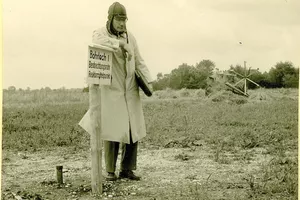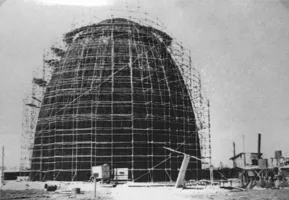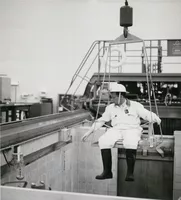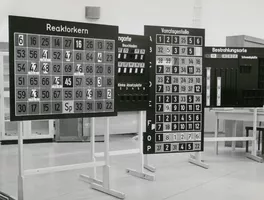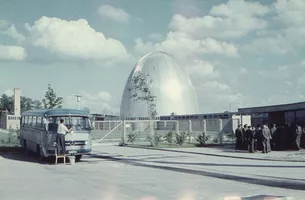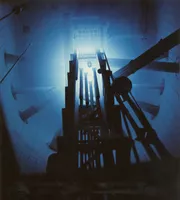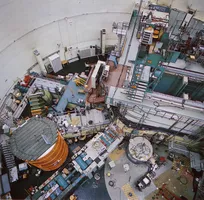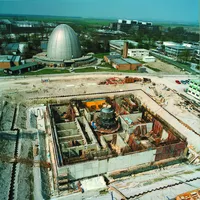Forschungsreaktor München
From "Atomic Egg" to FRM II
The research reactor Munich (FRM), known as the "Atomic Egg", came into operation on 31 October 1957 after only 11 months of construction and a 2-month planning period. It was the first nuclear facility in the young Federal Republic of Germany, established as part of the "Atoms for Peace" program initiated by President Eisenhower. It served exclusively as a neutron source for research and the training of young physicists and is the birthplace of neutron research in Germany.
Milestones in neutron research in Garching | |
|---|---|
| October 1957 | FRM I in Garching goes into operation |
| August 1996 | Groundbreaking ceremony for the construction of the FRM II |
| July 2000 | End of operation of the FRM I |
| March 2004 | FRM II goes into operation |
| June 2004 | Cooperation agreement between the Technical University of Munich and Forschungszentrum Jülich, foundation of the Jülich Centre for Neutron Science (JCNS) |
| January2011 | Cooperation agreement between the BMBF, the Bavarian State Ministry of Science, Research and the Arts, the three Helmholtz Centers in Jülich, Geesthacht and Berlin and the Technical University of Munich on cooperation and promotion of scientific use at the FRM II. |
| Februrary 2013 | Foundation of the Heinz Maier-Leibnitz Zentrum as the world's leading center for neutron research in Germany. |
Builder Heinz Maier-Leibnitz
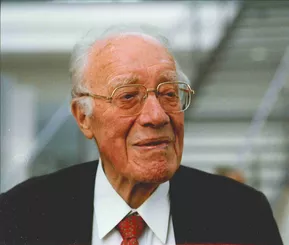
The originators of the FRM were the former Energy Minister, Dr. Franz Josef Strauß, and the Bavarian President, Wilhelm Högner; the "builder" of the research reactor Munich was the physicist Professor Heinz Maier-Leibnitz (1911-2000), who later used his experience in the establishment of the German-French neutron research center Institut Laue-Langevin (ILL, commissioning of the high flux reactor in 1971) in Grenoble. Between 1967 and 1972, he was the first Director of the ILL. During the construction phase in Grenoble, the ILL had an outstation in Garching. In 1972, the Nobel Prize winner and former PhD student of Maier-Leibnitz, Prof. Rudolf Mössbauer, assumed the directorship of the ILL. The use of neutrons in science and research also expanded in Germany. As the Soviet Union did not wish to be shown at a disadvantage in their zone, the future GDR, the Rossendorf research reactor went into operation on 16 December, 1957. On the recommendation of Prof. Maier-Leibnitz another of his graduate students, Professor Tasso Springer, joined the Institute for Neutron Physics at the Research Centre Jülich, (KFA-Jülich at that time), as Director. The Institute of Neutron and Solid State Physics Jülich (IFF) with a total of 10 sub-institutes, including three sub-institutes for neutron scattering (Prof. T. Springer, Prof. H. Stiller and Prof. W. Schmatz) was founded in May 1970. Key findings in neutron research and method development were carried out at the Jülich reactors MERLIN (1962-1985) and DIDO (1962-2006).
Further neutron sources in Germany
As a further neutron source in Germany, the research reactor FRG-1 at GKSS (Society for nuclear energy utilization in shipbuilding and shipping mbH, today Helmholtz-Zentrum Geesthacht HZG) came into operation on 23 October, 1958, supplying materials research with neutrons until 28 June, 2010. The Forschungszentrum Karlsruhe ran the neutron source FR-2 from 7 March, 1961 to 21 December, 1981. The Helmholtz-Zentrum Berlin, formerly the Hahn-Meitner Institute, operated BER II from December 1972 until its shutdown on December 11, 2019, with a significant increase in performance in the meantime.
As early as the mid-80’s the idea was mooted to significantly increase the FRM’s capacity. Finally, the concept of a new building emerged as the most sensible technically secure solution; the groundbreaking ceremony for the new building took place on 1 August 1996. The research neutron source Heinz Maier Leibnitz (FRM II) reached its first criticality on 2 March, 2004 and user operation began only one year later on 29 April, 2005. The FRM, however, ceased operating on 28 July, 2000, as the staff there was needed to operate the FRM II.
Focus of German neutron research in Garching
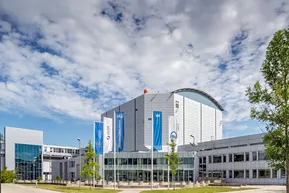
With the establishment of the Jülich Centre for Neutron Science (JCNS) in 2006, the focus of neutron research at Julich shifted to external sources, to a large extent to the very successful FRM II operational since 2005. After the FRG- 1 was also switched off in 2010, the Geesthacht materials researchers followed the Jülich model with the newly established "German Engineering Materials Science Center" (GEMS) and transferred their neutron scattering activities to the FRM II. The close collaboration between the TUM, FZ-Jülich and HZG at FRM II in Garching, led on 1 January 2011, to the establishment of a cooperation, under the name Heinz Maier-Leibnitz Zentrum (MLZ), between the three institutions with the aim of making scientific use of the FRM II, which nowadays provides German and international researchers with neutron and positron beams.
